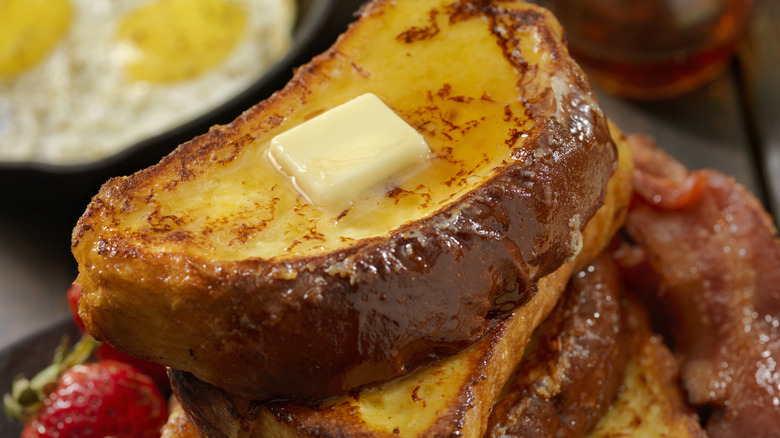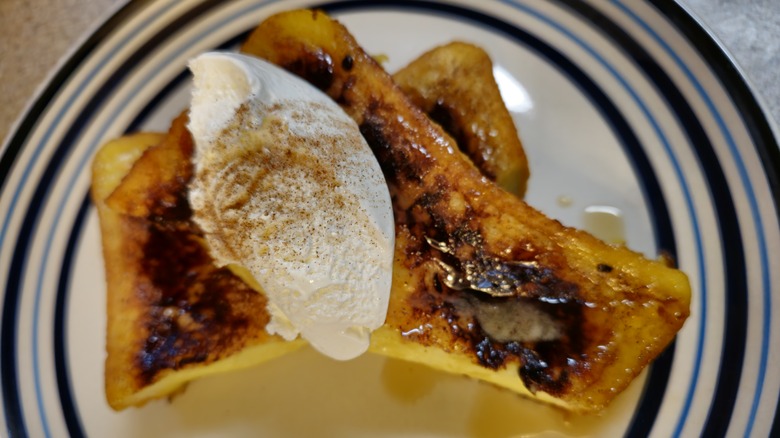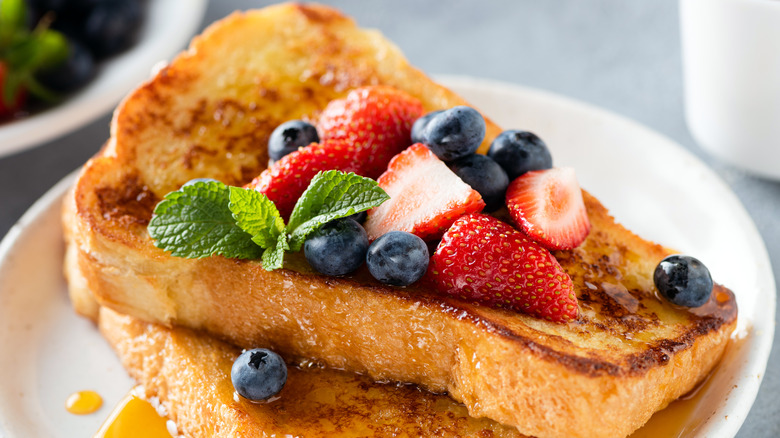The Unexpected Boozy Addition You Need For Elevated French Toast
Despite bearing a geographically unambiguous title, the actual locale in which French toast was initially conceived is a matter of historical record, and it may surprise you. As early as the fifth century, Roman chefs were frying up batches of Pan Dulcis, bread thoroughly soaked in a rich egg and milk mixture. Historians also believe that the dish originated as a means of preserving one's bread, as the milky mixture could revitalize even an entirely stale slice. The nationalistic nickname for the dish didn't come about until the 1870s when a recipe for French toast was first published in the "Encyclopedia of American Food and Drink."
But attributing the breakfast bread entirely to France would be fallacious. In fact, there is an unbelievable variety of ways that you can enjoy French toast around the world. As previously established, the dish is Roman by birth, but the recipe was only recorded in the United States hundreds of years later. However, in order to bring your French toast to the next level, you need to get another nation involved – Ireland. Adding a splash of Irish whiskey to the custard you prepared for your bread's soak will fundamentally transform the flavor of your French toast.
Irish whiskey in your French toast
The precise pour of Irish whiskey that you should use in your French toast recipe ultimately comes up to taste. Of course, whiskey has a rather pungent flavor, so it would behoove a home cook to infuse booze into their breakfast cautiously.
Every piece of French toast begins its journey by being briefly submerged in a mixture of eggs, milk, and other flavorful ingredients. Here, you can find any number of delicious ingredients in French toast. Additionally, there are countless toppings that you can choose between to put the finishing touches on your breakfast. It is at the earliest stages of custard creation where you should add in the Irish whiskey so that it will thoroughly soak into your pre-cooked bread.
In general, a recipe may call for you to add the same amount of Irish whiskey into the French toast dip as the recipe calls for vanilla extract because the two flavors are complementary to one another. It's worth noting that there is another tried-and-true method for adding a boozy elevation to your French toast. Infusing booze, particularly a splash of Irish whiskey, into your homemade whipped cream to top your French toast is a great way to achieve a comparable flavor profile to the infused custard method.
Will a boozy French toast brunch get you tipsy?
Before you delve into the world of alcoholic breakfast dishes like whiskey-infused French toast, it's worth noting that the intoxicating effects of Irish whiskey will be next to negligible in an alcoholic dessert bake. By the time your dessert has been divided up, the individual servings will probably not have enough alcohol to have any effect on those who are eating the dish, though you should be aware that your breakfast bread will still pack an alcoholic punch.
According to Food Network, a study carried out by the U.S. Department of Agriculture tells us that the relatively short in-pan time required in your boozy French toast recipe wouldn't be enough to fully cook off the alcohol content of the Irish whiskey. For example, a recipe like Bailey's French toast, which would utilize a heavy, cream-based alcoholic product that has an ABV of 16%, would be considerably less boozy than a similar soaking sauce made from, for example, Jameson Irish whiskey, which more than doubles the booziness of a Bailey's batch by packing a 40% ABV punch. However, the relatively small portions of alcohol that boozy French toast recipes generally call for shouldn't incite intoxication.


